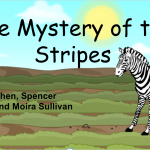Contributed by Grace Lee
Why do giraffes have long necks? The theory is quite more complicated than expected. Although it’s something that we rarely question, evolutionary scientists have been debating the answer to this question for years. Conveniently, this matter addresses a common theme and misunderstanding of evolutionary biology that we can learn from.
To begin, there are two leading hypotheses as to why giraffes have such long cervical vertebrae. The first, known as the ‘competing browsers’ hypothesis, states that their long necks evolved over time to gain the advantage of being able to reach the leaves of tall trees for feeding. The second, known as the ‘necks for sex’ idea, states that this trait evolved as a weapon that allows males to battle each other to gain dominance for mating with females.
A common misconception is that natural selection produces animals that are perfectly suited for their environment. Unfortunately, evolution does not work to create the “perfection version” of an organism. For example, while it seems that it would be advantageous to have the longest neck in the population, studies show that long necks require increased nutrition for maintenance of health and extreme blood pressures to pump blood from the heart to the brain. Furthermore longer necks may attract predators more easily and may slow down escaping. Evolution is filled with many trade-offs in which a trait is beneficial in one context but harmful in another. There could potentially be a giraffe that not only is suitable for battling rivals and feeding off tall trees but also at the same time easily hidden from predators, but evolution may not necessarily be working towards an “upgrade.”
So what is the correct answer? Perhaps, an unsatisfying “both.” The ‘competing browsers’ idea doesn’t work alone because in the driest seasons, when it would seem the most beneficial to have the longest neck to reach for leaves no other animals could, giraffes tend to feed from shrubs. Even ordinarily, giraffes often feed at shoulder level and “bend over” to do so. The ‘necks for sex’ idea also doesn’t work alone because it doesn’t explain why female giraffes have long necks since they don’t engage in battles for mating.
This returns us to a common theme of evolutionary biology. Evolution is “survival of the fit enough,” more so than “survival of the fittest.” It doesn’t require perfection. Many organisms with varying traits are able to survive and reproduce, and this perhaps leads to the beautifully diversity we see today. The giraffe may not be the perfect organism, but the giraffe is the perfect giraffe.


Check out some of the recent research on Giraffe Necks:
Badlangana, N. L., Justin W. Adams, and Paul R. Manger. 2009. The Giraffe (Giraffa Camelopardalis) Cervical Vertebral Column: A Heuristic Example in Understanding Evolutionary Processes? Zoological Journal Of The Linnean Society 155.3: 736-57.
Mitchell, G., S. J. Van Sittert, and J. D. Skinner. 2009. Sexual Selection Is Not the Origin of Long Necks in Giraffes. Journal of Zoology 278.4: 281-286.
Simmons, R. E., and R. Altwegg. 2010. Necks-for-sex or Competing Browsers? A Critique of Ideas on the Evolution of Giraffe. Journal of Zoology 282.1: 6-12.
Simmons, Robert E., and Lue Scheepers. 1996. Winning by a Neck: Sexual Selection in the Evolution of Giraffe. The American Naturalist 148.5 : 771-786.
Solounias, N. 1999. The Remarkable Anatomy of the Giraffe’s Neck. Journal of Zoology 247.2: 257-268.
Taylor, M. P., D. W. E. Hone, M. J. Wedel, and D. Naish. 2011. The Long Necks of Sauropods Did Not Evolve Primarily through Sexual Selection. Journal of Zoology 285.2 : 150-161.
Wilkinson, David M., and Graeme D. Ruxton. 2011. Understanding Selection for Long Necks in Different Taxa. Biological Reviews: 616-630.

